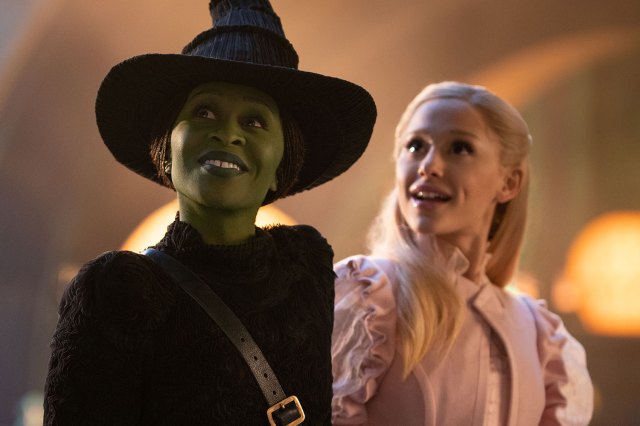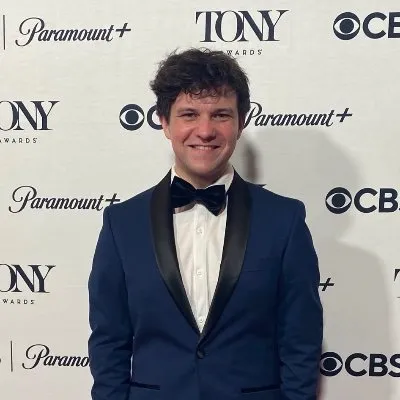Wicked movie review – let us rejoicify, it’s almost perfect
Something good has happened in Oz

It would be fascinating to know what someone who had never heard or seen Wicked made of the first instalment of Jon M Chu’s two-part musical bonanza.
Hitting the big screen after an incredibly protracted development process (at one point a release date was set for October 2015, and Harry Styles was said to be orbiting the role of Fiyero), it now hurtles into cinemas faster than a witch pelting her way to the western sky on an enchanted broomstick.
But we’re WhatsOnStage, not WhatsOnScreen, so it’s best to assume readers have some degree of familiarity with Elphaba, the green-skinned magical pariah. In Gregory Maguire’s revisionist series of novels based on L Frank Baum’s characters, she becomes a protagonist battling the malevolent manipulations of a tyrannical Wizard in the less-than-merry old land of Oz.
As it is on stage, Maguire’s tale is radically re-interpreted for Wicked by screenwriters Winnie Holzman and Dana Fox (Holzman did the musical’s book solo). Rather than an aquaphobic, cruel monster, Elphaba is a snarky anti-hero whose principles lead to an anti-establishment streak. It is the establishment, therefore, that portrays her as a “wicked witch”: the reality is much more complicated.
The headline here is that Chu’s Wicked is about as good as it could ever be. It’s hard not to fall in love with every pixel of the vibrant world he and his team have laid out before us. The greatest triumph lies in the creative effort undertaken, with the sheer scale of technical design, costuming and set construction nothing short of mind-boggling. What could have ended up as a sterile, green-screen-stuffed Oz becomes a tangible, lived-in space. Importantly, this fantasy world feels very real. This is helped by having the actors singing live on set (frowned upon, admitedly, during films like Les Misérables, but used to great effect here).
Take Elphaba’s “I Want” number “The Wizard and I”: you don’t just see the fantastical buildings Cynthia Erivo is walking through (kudos to the team for the Gaudi-esque technicolour and vibrancy), you can almost hear the echoes coming off the Shiz University masonry.
Erivo is an excellent Elphaba: there was never a world where she wouldn’t be. All the necessary stoic, cynical charm of someone spending their live confined to the margins while grappling with great power is present. But it’s not all belt and braces: she manages to find an undercurrent of tenderness in numbers like “I’m Not That Girl”, or in her relationship with younger sister Nessarose (Marissa Bode, underused slightly here but likely to come into her own in part two).
The stand-out star of the film, however, has to be Ariana Grande‘s pastel-pink prim Glinda – later the Good Witch that helps Dorothy along her way down the Yellow Brick Road, but starting out as a spoilt, entitled social queen bee (named Galinda, mind). Grande has found a Glinda for the screen, rather than simply transplanted a Glinda from the stage. She knows there is as much comedy in a small gasp as there is in an Annaleigh Ashford-esque lunge across a room (that’s a reference for the true Wicked fans). Forget pink, this is a modern-day Scarlett O’Hara through and through.

There are some charismatic performances from Jonathan Bailey (Fiyero) and his well spoken horse, as well as Michelle Yeoh’s Madame Morrible: providing enigmatic foreboding as Elphaba discovers the limits of her powers. Bailey’s performance in “Dancing Through Life”, staged as if Inception had decided to whack in a musical number, acts as high mid-point for the flick.
Wicked has produced some of the most well-known musical tunes of the century, and Chu has brought his signature kinetic flare here. The highlight has to be the music video-style editing of “What Is This Feeling?”, pitting Grande and Erivo against one another in a whirligig of jealousy and pettiness. The other big, dance-heavy numbers (spot some fantastic familiar faces!) are each soaked with joy.
Cinematographer Alice Brooks, who worked with Chu on his last film In the Heights and with Lin-Manuel Miranda on tick, tick… Boom!, repeats the same trick of knowing exactly how to shoot musical numbers: long takes, wide shots, let the visual flare of Christopher Scott’s choreography and Paul Tazewell’s costume designs dazzle. It lets the film breathe: nothing feels frantic or rushed.
There was scepticism when it was revealed that the stage show is being split into two cinematic experiences, but it’s hard not to see the appeal: more time to alight on characters, fill in gaps and expand on some of the stage show’s more fleet sections. Watching Elphaba and Fiyero’s relationship blossoming earlier is particularly successful, while scenes showing the early years of her life justify her righteous fury at the treatment of the talking animals experiencing “Something Bad” happening in Oz.
Coming in at two hours 30, there’s a case to be made for 20 minutes or so to be taken out, with the pace slipping slightly once Elphaba and Glinda set off from Shiz University to the awe-inspiring Emerald city. I’d almost argue that Chu’s faithfulness to the original stage production means he is less keen to make the tougher choices (do we really need Jeff Goldblum crooning “A Sentimental Man”? Probably not…).
The emotional “oomph” of “Defying Gravity” is dampened by extended passages of dialogue between verses, so there’s slightly less of the heady euphoria that you get at the close of act one on stage. Those are small nitpicks, from someone who has spent a lot of time over the last decade pining for this film to emerge.
If you like Wicked in the theatre, chances are you’ll love the film. If you loved Chu’s work on In the Heights, you’ll definitely love this film. If you don’t like either of those things, then the sheer scale of the spectacle will probably win you over. Chu hasn’t just defied gravity, he’s defied any naysayers. Bring on part two!


















